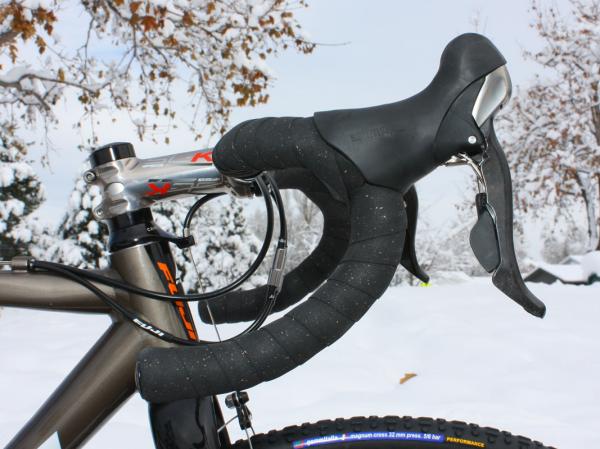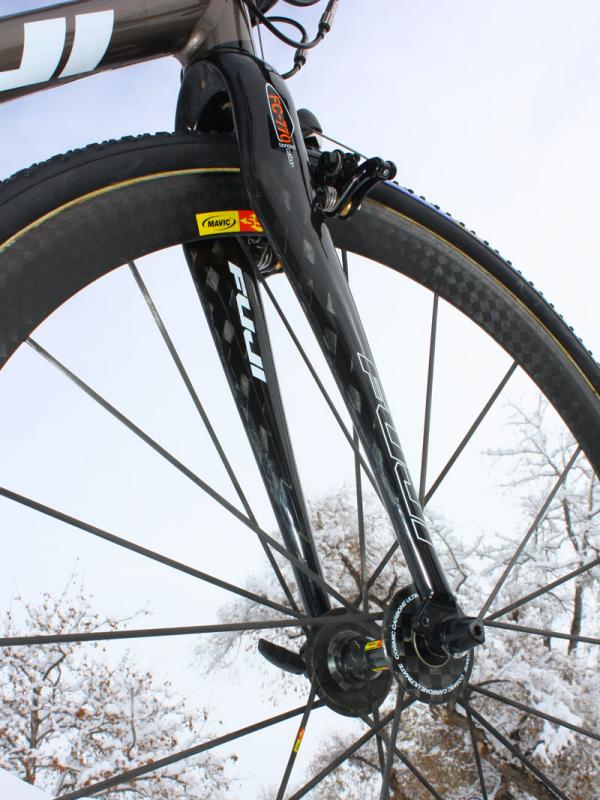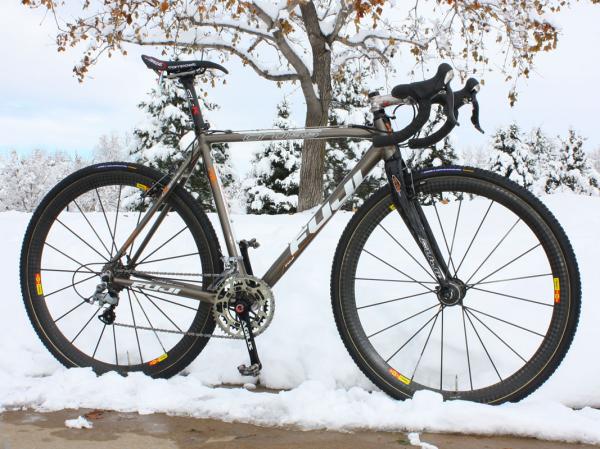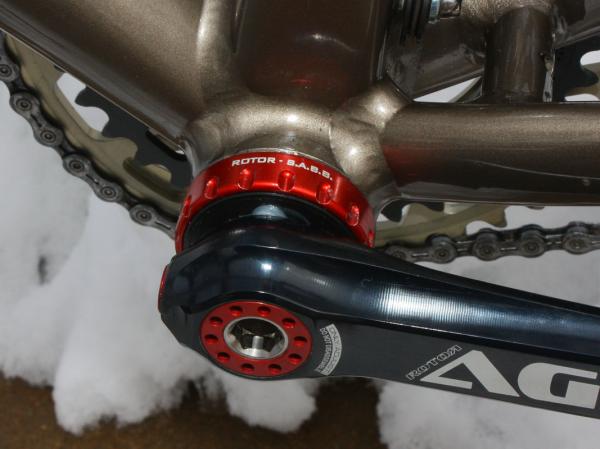Davide Frattini's Fuji Cross RC
Bone stock with a few key upgrades


























Davide Frattini (Fuji) was an early adopter of carbon fiber in 'cross with his Blue Competition Cycles CXC back in 2006 but changes in teams and sponsors ironically now put him back on an all-alloy Fuji Cross RC for the 2009-10 season. Not surprisingly, Frattini's new bike is a fair bit heavier than what he used three years ago – by a significant 0.6kg (1.3lb) – and one of his competitors we spoke with before the recent Boulder Cup in Boulder, Colorado even playfully mocked it as "a tank" at 8.20kg (18.08lb).
Fuji builds its top-end 'crosser with a proprietary 'A6 quaternary alloy', which Fuji claims is 35 percent stronger than typical aluminum alloys and allows for thinner walls in the weld zones as a result. Tube shaping is fairly aggressive: the down tube is slightly ovalized at both ends, the top tube is highly flattened for shouldering comfort, the seat tube flares from round to rectangular below the front derailleur clamp, and the chain stays and seat stays both take an 'S'-shaped path from end to end. Up front, an integrated head tube surrounds a straight 1 1/8" alloy steerer mated to an alloy crown and carbon blades.
Claimed frame weight is a competitive 1,530g (3.37lb) but the mixed material fork is a comparatively hefty 750g.
However, as always, weight isn't everything. Frattini crossed the Boulder Cup line ahead of said competitor (who was on a much lighter machine) and regularly lands in the top-ten at major US races. In fact, the former 'Baby' Giro d'Italia winner is quick to point out that in some areas, the additional mass has lent performance gains, not losses.
"[The Fuji Cross RC] is one of the very few bikes that I've never had a problem with the fork chattering without having to toe-in the brake pads," Frattini said. "I rode full carbon bikes or aluminum with carbon rear stays in the past and the Fuji Cross RC has only a carbon fork. But despite this, it still has good stiffness without being a heavy bike."
Instead of focusing on weight, Frattini emphasizes the importance of good handling characteristics and the ability to maintain traction since the courses can be quite technical and typically incorporate very little climbing. Interestingly, he also adds that while stiffness is generally good, there is such a thing as too much of it when the conditions are loose.
"In cyclo-cross you have a lot of cornering and acceleration so I prefer a bike that has great handling and enough stiffness without being too snappy," he said. "A 'cross bike doesn't need to be overly snappy because as soon as you push the pedals on a turn the bike will react. In the slow turns you can lose the handling of the bike."
The latest race content, interviews, features, reviews and expert buying guides, direct to your inbox!
Frattini's race machine starts life as a fully stock Cross RC complete bike, including the second-tier Shimano Ultegra component group – essentially the functional equivalent of Dura-Ace but a touch heavier. A collection of personal sponsors cleaves off a good chunk of mass from the rest of the stock build's 8.7kg (19.14lb) figure, though, while also upping the overall performance ante.
Substitutions include a Rotor Ágilis compact crankset with matching Q-Ring 36/46T elliptical chainrings, FSA SL-K carbon bars and alloy stem, a radical looking Selle SMP Composit Carbon Rail saddle, and top-notch rolling stock in Mavic Cosmic Carbone carbon wheels and Gommitalia's lighter-edition Magnum Cross Performance 32mm-wide tubulars.
Frattini seems particularly fond of the new chainrings though not for their purported efficiency advantages but rather their ability to maintain grip.
"They work great. I felt weird when I started using it but soon after I really felt my spin was smoother and rounder, like I was always pushing," he said. "[I get a] more well-rounded, smooth spin, without any dead spots improves your traction. In cyclo-cross it's important to have as much traction as possible."
Likewise, tire pressure is carefully tuned based on course conditions to maximize grip.
"I like to run low pressure and almost feel the tire 'works' on the rim, which can be uncomfortable for a roadie to feel that kind of sensation," Frattini said. "Usually I start the warm-up with two bars [29psi] and then manually take out some air until I feel comfortable on the corners. The amount of air I take out depends on the terrain: less if it's dry and more if it's muddy. It is really a feeling, not a number, based on the different courses. Basically I ride almost touching the rims and try to flow as much as possible."
Function over flash, form over fashion. While other competitors might lament having to use a heavier machine, Frattini's pragmatic approach seems to be serving him well. In this past weekend's Mercer Cup in West Windsor, New Jersey, Frattini finished fifth on Saturday and seventh – plus the hole shot – on Sunday.
"You don't really need the nicest or lightest or most expensive bike out there. For 'cross you should look more for a bike that is robust and strong and has good handling because that will excel your own handling skills and that is really what cross is about."
Complete bike specifications